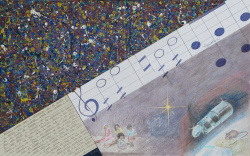Symphony is an independent musical work, executed by orchestra of strings, wind and percussion instruments, usually developed in four movements, the first of them is built as sonata form. The modern symphony is, actually, a great sonata for orchestra.
Musical gender created about 1750, the symphony had many great cultists, like Haydn, Mozart, Schubert, Mendelssohn, Schumann, Brahms, Franck, Tchaikovski, Dvorak, Bruchner, Mahler, Berlioz, Liszt, Sibelius, Prokofiev, Stravinski and other. Above these masters, hovers the huge figure of Beethoven, the greatest symphonic composer of all times and one of the most powerful personalities of the whole art history.
Beethoven delegated to mankind 9 symphonies that cross over the years without wear and tear signs, as works of supreme and permanent artistic value. Beethoven's influence on composers of the XIX century and even XX, was dominant and the fascination of his work extrapolates the domain of the music to manifest, until today, in several fields of the artistic creation.
In 1981, the painter Walter L. L. Miranda invited some plastic artists to create works referenced or inspired on Beethoven's nine symphonies. Almost three years later, he Maria Bertoldi and Roberto Giannecchini (GIA) showed the outcome of this experience that excited them. During the development of the series, they established that, besides the nine basic works, each one would produce more three, giving free sequence to the creative process.
Personalities of different formation, information and temperament, each one created inside of their line and the results are more than satisfactory: they show fundamental problems of the artistic creation and they approach the metalanguage of the critic, in the measure that they create works referenced on other works of art. Their creative postures sometimes resemble certain behaviors of own Beethoven, whose deeply intellectual positioning transforms some of his works or part of them, first of all, in spiritualized visions of the life than in direct projections of its flowing.
WALTER L. L. MIRANDA projected in the works that he accomplished on cardboard his own personality, rich and complex. And he did, at the same time, in a rational and passionate way. An attentive personality to the significant progresses of the knowledge and, to the madness practiced by segments of the society on behalf of doubtful ideals, deeply concerned with the social problems and the man's destiny in the earth. In the group of his work, it is felt a message of hope.
MARIA BERTOLDI let herself to impregnate by the romantic component that coexists with the tragic feeling in the group of Beethoven's symphonies. She materialized the life that breathes in these symphonic poems by representations of the urban landscape that is seen from the windows of her house-studio, in the neighborhood of Agua Fria, in Sao Paulo. She worked more in the poetic line of the Seventh Symphony than in the tragic slope of the Symphony of the Destiny, the Fifth.
GIA built a beautiful work using in his sculptures-objects pieces of matted aluminum and scraps of computers, incorporating to them elements supplied by the modern technology as fluorescent lamps, rigid optic fibers, polyurethane strings, small motors and timers. Some pieces are fixed, other move. The Sixth Symphony - The Pastoral - was exemplarly synthesized in an aluminum figure of a bird that “flies” smoothly, moved by a motor of 18 watts provided with a mechanical resonance system, moved by a timer.
The whole works presented by the three artists has the mark of their Beethovenian origin: the spirit of faith in the art and in the life that it reflects. It is as if they repeated, in other languages, the verses of the ODE TO JOY, of Schiller, in the end of the Ninth Symphony:
“EMBRACE EACH OTHER, YOU MILLIONS! / THIS KISS IS FOR THE WHOLE WORLD!...”
Enock Sacramento - Sao Paulo, Christmas 1984
Member of the Brazilian Association of the Critics of Art
